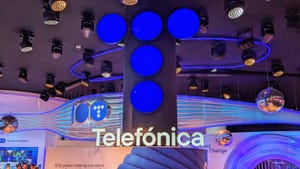And then there was (The Network of) One
I’ve been in Munich for the last couple of days, listening to Nokia Siemens Networks executives tell us industry analysts all about the new company strategy. Bearing in mind who the parents of this joint venture are, old skool bastions of Northern European communications engineering, renowned for delivering solid products with solid performance, the company at first seemed to have gone all soft and fluffy.
September 30, 2009
By Julian Herbert
I’ve been in Munich for the last couple of days, listening to Nokia Siemens Networks executives tell us industry analysts all about the new company strategy. Bearing in mind who the parents of this joint venture are, old skool bastions of Northern European communications engineering, renowned for delivering solid products with solid performance, the company at first seemed to have gone all soft and fluffy.
“We help CSPs [Communications Service Providers] build more valuable relationships with their customers” declared Michael Matthews, Head of Strategy and Business Development, in the opening session on Monday morning. What ever happened to technology? What emerged through the presentations was a clear message that Nokia Siemens Networks (NSN) has changed and that it sees its future in being a trusted partner, rather than a vendor of telecoms equipment.
On the first day executives delivered presentations covering the way NSN has moved from selling producs to selling solutions and services. The leitmotif of the day was a strategic quadrant. You know the sort. It showed networks bottom left, moving through services and efficiency top left, to experience top right – accompanied liberally by the language of the new strategy: transformation, end-user-centricity, transformation, commitment to professional services and, yes, transformation. Just in case you missed it, NSN was telling the audience that it has been through a transformative process over the past two and half years and that it now sees its role as that of trusted partner, helping operators achieve the transformation of their businesses from networks to services and from efficiency to enhanced user experience. Transformation.
The day closed with a presentation from Stephan Scholz, CTO, to bring all these strands together. He hailed NSN’s new strategy, which has a faintly ethereal name: The Network of One. Herr Scholz explained that it is “a long term view of how CSPs can provision networks to deliver the networks of the future”. There are six strands to the strategy (and you should put “One” in front of each part for the full effect):
* unified management and charging system
* simplified network
* convergent service control
* business optimised operation
* single view of customer data
* flexible service enablement
…arranged in a circle with the end-user in the middle.
Sound familiar? It does sound a bit like Alcatel’s pre-merger “user-centric broadband”, but it is unlike that strategy which saw broadband as an enabler of advanced services. The slightly uneasy use of new age language (I particularly enjoyed “this is our holistic approach to boost efficiency and end-user experience”), belies the fact that NSN wants this strategy to be grounded in practicalities, namely:
* Centralising of control of fixed and mobile access networks
* Convergence of the fixed and mobile core networks
* Simplifying of optical access, aggregation and transport networks
* Optimising data transport
At first glance it looked like a giant marketing pitch, sort of presenting the Rolls Royce in order to sell either the family saloon or perhaps running repairs to the old jalopy. We were told that this is not the case: ripping out a mass of legacy backhaul, transport networks, billing systems and manual or semi-automatic management and control processes and replacing these with shiny new stuff isn’t going to happen in one fell swoop (21CN was mentioned more than once). The Network of One is a company philosophy and a statement of direction but it is also a wrapper for a series of measures which a network operator can take in part or as a whole, if it buys into the idea that its business model needs to change. There was a subtext too, I think: it throws the gauntlet down to certain other vendors whose USP is price. The message to operators is “we may not be the cheapest in terms of capex, but the opex saving will make the investment worth the pain”.
Oh and yes, before you ask. I did go to the Oktoberfest on Monday night with fellow analysts. Great fun it was too. I can confirm: I did eat stodge, I did drink beer, I did stand on the table, I did sing “ein Prosit, ein Prosit der Gemuetlichkeit” quite a lot. I did not wear lederhosen.
Read more about:
DiscussionYou May Also Like








.png?width=300&auto=webp&quality=80&disable=upscale)


_1.jpg?width=300&auto=webp&quality=80&disable=upscale)